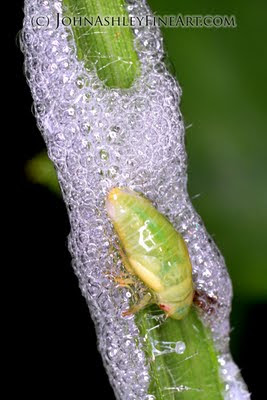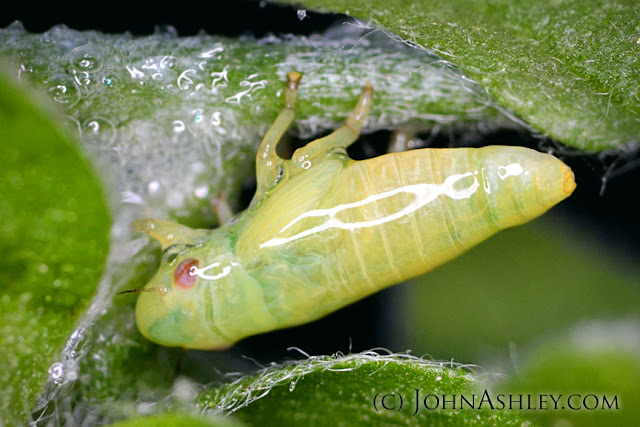 |
| Larval spittlebug emerging from its spittle home |
A golf ball-sized lump of white froth, found clinging to a plant stem in the local weed patch, is a captivating kid-magnet that simply must be investigated. We didn't have the internet or computers back then, and they didn't even invent guidebooks until we were much older. So for years I didn't know if the spittle was made by the plant or by the little bug that we sometimes found hiding in the foam.
Times have changed all of us kids, but the captivating "spittlebugs" remain.
Today we know that spittlebugs (family Cercopidae) are named for the white froth made by the larval stages of this very common insect. We also know the adults as "froghoppers," and as the high jump champions of the insect world, thank you very much. Move over fleas.
But first, about that froth.
Spittlebugs overwinter as egg masses that hatch in early summer. The wingless larvae, about one-quarter inch in size, create the frothy white abodes where they will grow through five moults before leaving home in late summer as adults. As larvae, they feed on plant sap sucked out through a specialized, needle-like feeding tube.
Sugar-rich phloem sap moves down from the plant's photosynthetic leaves, but for some reason the spittlebugs tap into the sugar-poor but mineral-laden xylem sap flowing up from the water-pumping roots. The larvae have to drink lots of liquid to grow into an adult, and therefore they also have to excrete lots of liquid.
So the so-called "spittle" is really a gentlemanly way of saying piddle. It really originates from the other end of the bug. But wait, it gets even better. The larvae also use the tip of their abdomen to, um, "blow bubbles" into this liquid to form froth. What possible body function combination could be more kid-captivating?
The sticky froth serves the spittlebug well. It hides the bug, protects it from parasites, and prevents it from drying out. It also deters some predators (and attracts some boys) with the "yuck factor."
 |
| 1/4" long spittlebugs require five instars, or larval stages, before turning into adults and leaving the spittle behind. |
The ants, meanwhile, are one of our most underestimated critters. While the spittlebugs' froth apparently irritates their appendages, the ants have nonetheless learned how to use the sticky froth to build their own temporary housing. Up in some of the same plant neighborhoods where spittlebugs live, ground-dwelling ants also tend to their herds of aphids - yet another fascinating, plant-juice-sucking insect (more on aphids in a later edition).
Ants defend aphids from predators while drinking the sugar-rich "honeydew" excreted from the aphids' rear ends. Up in the plants, the ground-dwelling ants sometimes build temporary tents out of soil and thatch to corral and protect their aphid herds. What do they use to glue their aphid-tents together with?
Why, spittle of course. Sometimes the ants use rain-soaked soil, but spittle makes a better, stronger glue.
But the ants don't like to touch spittle, so they carry up pieces of dry soil and stick them to the outside of the spittle mass. The spittle gets soaked up by the soil and thatch and, presto, the ants have a tent to camp in and use to protect their herds. Sometimes, this also enables the ants to capture and consume the larval spittlebug.
Ant predation has localized effects on spittlebug populations, but many spittlebugs still piddle their way through youth to become high-jump-champion adults. When spittlebugs reach this golden age, about one month old, we call them "froghoppers."
| Three froghoppers on a knapweed bud |
Froghopper jumps have been measured at just over 27 inches high, a little higher than the best flea athlete. But froghoppers weigh in at more than 60 times heavier than fleas. If you compare how much force animals can generate per body weight, froghoppers win hands-down: froghoppers 400X, fleas 135X, humans 2-3X.
During a froghopper jump, the initial acceleration is somewhere in the neighborhood of 8,900 mph. A human astronaut blasting off into space experiences a g-force of 5 gravities or less. Our neighborhood froghopper, on the other hand, generates a g-force of more than 400 gravities on a good jump.
That's substantially more than a little bit impressive.
For a neighborhood bug that lives in a patch of weeds, grows up in spittle, and weighs less than 0.000026 of a pound, the froghoppers posses athletic skills that can impress and inspire kids of any age. If only we lived in a just world, we would see school mascots named, "The Spittlebugs," and professional sports teams named, "The Froghoppers." If only.
 |
| As adults, froghoppers turn golden-brown in a variaty of patterns. |

